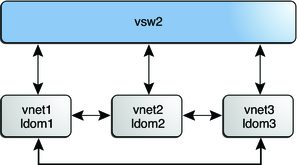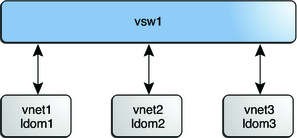| Skip Navigation Links | |
| Exit Print View | |

|
Oracle VM Server for SPARC 2.2 Administration Guide Oracle VM Server for SPARC |
| Skip Navigation Links | |
| Exit Print View | |

|
Oracle VM Server for SPARC 2.2 Administration Guide Oracle VM Server for SPARC |
Part I Oracle VM Server for SPARC 2.2 Software
1. Overview of the Oracle VM Server for SPARC Software
2. Installing and Enabling Software
3. Oracle VM Server for SPARC Security
4. Setting Up Services and the Control Domain
Introduction to a Virtual Network
Oracle Solaris 10 Networking Overview
Oracle Solaris 11 Networking Overview
Virtual Device Identifier and Network Interface Name
How to Find Oracle Solaris OS Network Interface Name
Assigning MAC Addresses Automatically or Manually
Range of MAC Addresses Assigned to Logical Domains
Automatic Assignment Algorithm
Duplicate MAC Address Detection
Using Network Adapters With Logical Domains
How to Determine If a Network Adapter Is GLDv3-Compliant (Oracle Solaris 10)
Configuring a Virtual Switch and the Service Domain for NAT and Routing
Configuring NAT on an Oracle Solaris 10 System
How to Set Up a Virtual Switch to Provide External Connectivity to Domains (Oracle Solaris 10)
Configuring NAT on an Oracle Solaris 11 System
How to Set Up a Virtual Switch to Provide External Connectivity to Domains (Oracle Solaris 11)
Configuring IPMP in a Logical Domains Environment
Configuring Virtual Network Devices Into an IPMP Group in a Domain
Configuring and Using IPMP in the Service Domain
Using Link-Based IPMP in Logical Domains Virtual Networking
How to Configure Physical Link Status Updates
Configuring and Using IPMP in Releases Prior to Logical Domains 1.3
Configuring IPMP in the Guest Domain
Configuring IPMP in the Service Domain
How to Assign VLANs to a Virtual Switch and Virtual Network Device
How to Install a Guest Domain When the Install Server Is in a VLAN
How to Configure a Virtual Switch With an NIU Network Device
Using Link Aggregation With a Virtual Switch
How to Configure Virtual Network and Virtual Switch Devices to Use Jumbo Frames
Compatibility With Older (Jumbo-Unaware) Versions of the vnet and vsw Drivers (Oracle Solaris 10)
Oracle Solaris 11 Networking-Specific Feature Differences
11. Managing Domain Configurations
12. Performing Other Administration Tasks
Part II Optional Oracle VM Server for SPARC Software
13. Oracle VM Server for SPARC Physical-to-Virtual Conversion Tool
14. Oracle VM Server for SPARC Configuration Assistant (Oracle Solaris 10)
15. Using the Oracle VM Server for SPARC Management Information Base Software
16. Logical Domains Manager Discovery
17. Using the XML Interface With the Logical Domains Manager
A virtual network (vnet) device is a virtual device that is defined in a domain connected to a virtual switch. A virtual network device is managed by the virtual network driver, and it is connected to a virtual network through the hypervisor using logical domain channels (LDCs).
A virtual network device can be used as a network interface with the name vnetn, which can be used like any regular network interface and configured with the Oracle Solaris 10 ifconfig command or the Oracle Solaris 11 ipadm command.
Note - For Oracle Solaris 11, the devices are assigned generic names, so vnetn would use a generic name, such as net0.
You can add a virtual network device to a domain, set options for an existing virtual network device, and remove a virtual network device by using the ldm add-vnet, ldm set-vnet, and ldm rm-vnet commands, respectively. See the ldm(1M) man page.
See the information about Oracle VM Server for SPARC networking for Oracle Solaris 10 and Oracle Solaris 11 in Figure 8-1 and Figure 8-2, respectively.
Until the Oracle VM Server for SPARC 2.1 release, the Logical Domains Manager would assign LDC channels in the following manner:
An LDC channel would be assigned between the virtual network devices and the virtual switch device.
An LDC channel would be assigned between each pair of virtual network devices that are connected to the same virtual switch device (inter-vnet).
The inter-vnet LDC channels are configured so that virtual network devices can communicate directly to achieve high guest-to-guest communications performance. However, as the number of virtual network devices in a virtual switch device increases, the number of required LDC channels for inter-vnet communications increases exponentially.
You can choose to enable or disable inter-vnet LDC channel allocation for all virtual network devices attached to a given virtual switch device. By disabling this allocation, you can reduce the consumption of LDC channels, which are limited in number.
Disabling this allocation is useful in the following situations:
When guest-to-guest communications performance is not of primary importance
When a large number of virtual network devices are required in a virtual switch device
By not assigning inter-vnet channels, more LDC channels are available for use to add more virtual I/O devices to a guest domain.
Note - If guest-to-guest performance is of higher importance than increasing the number of virtual network devices in the system, do not disable inter-vnet LDC channel allocation.
The following figure shows a typical virtual switch that has three virtual network devices. The inter-vnet-link property is set to on, which means that inter-vnet LDC channels are allocated. The guest-to-guest communications between vnet1 and vnet2 is performed directly without going through the virtual switch.
Figure 8-3 Virtual Switch Configuration That Uses Inter-Vnet Channels

The following figure shows the same virtual switch configuration with the inter-vnet-link property set to off. That means that inter-vnet LDC channels are not allocated. You can see that fewer LDC channels are used than when the inter-vnet-link property is set to on. In this configuration, guest-to-guest communications between vnet1 and vnet2 must go through vsw1.
Note - Disabling the assignment of inter-vnet LDC channels does not prevent guest-to-guest communications. Instead, all guest-to-guest communications traffic goes through the virtual switch rather than directly from one guest domain to another guest domain.
Figure 8-4 Virtual Switch Configuration That Does Not Use Inter-Vnet Channels
